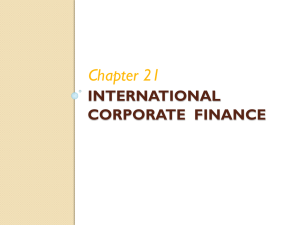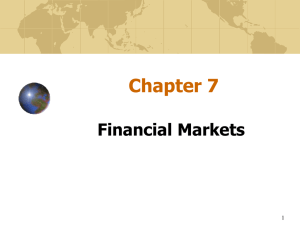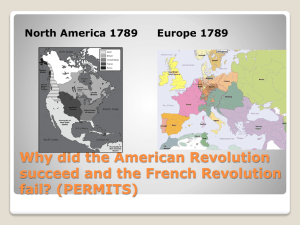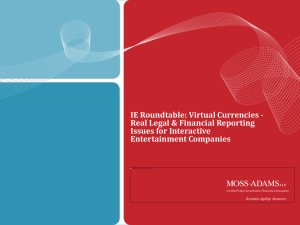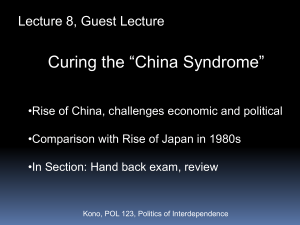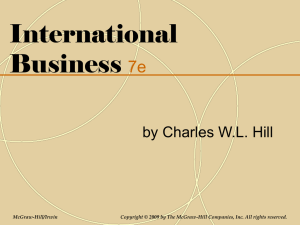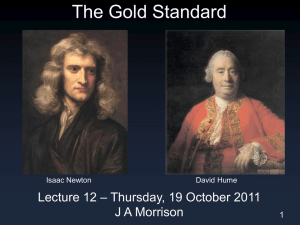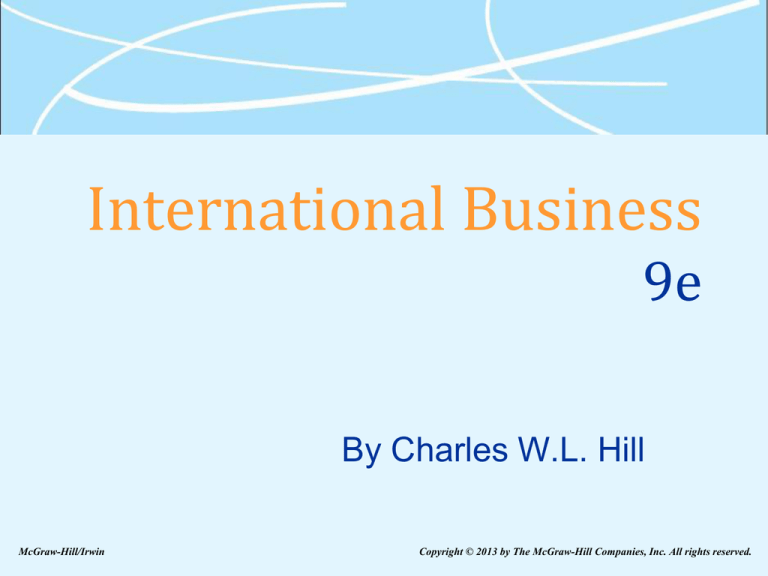
International Business
9e
By Charles W.L. Hill
McGraw-Hill/Irwin
Copyright © 2013 by The McGraw-Hill Companies, Inc. All rights reserved.
Chapter 10
The Foreign
Exchange Market
Why Is The Foreign
Exchange Market Important?
The foreign exchange market
1. is used to convert the currency of one country
into the currency of another
2. provides some insurance against foreign
exchange risk - the adverse consequences of
unpredictable changes in exchange rates
The exchange rate is the rate at which
one currency is converted into another
events in the foreign exchange market affect
firm sales, profits, and strategy
10-3
When Do Firms Use The
Foreign Exchange Market?
International companies use the foreign
exchange market when
the payments they receive for exports, the income
they receive from foreign investments, or the income
they receive from licensing agreements with foreign
firms are in foreign currencies
they must pay a foreign company for its products or
services in its country’s currency
they have spare cash that they wish to invest for short
terms in money markets
they are involved in currency speculation - the shortterm movement of funds from one currency to another
in the hopes of profiting from shifts in exchange rates
10-4
How Can Firms Hedge Against
Foreign Exchange Risk?
The foreign exchange market provides
insurance to protect against foreign
exchange risk
the possibility that unpredicted changes in
future exchange rates will have adverse
consequences for the firm
A firm that insures itself against foreign
exchange risk is hedging
10-5
What Is The Difference Between
Spot Rates And Forward Rates?
The spot exchange rate is the rate at which a
foreign exchange dealer converts one currency
into another currency on a particular day
spot rates change continually depending on the
supply and demand for that currency and other
currencies
Spot exchange rates can be quoted as the
amount of foreign currency one U.S. dollar can
buy, or as the value of a dollar for one unit of
foreign currency
10-6
What Is The Difference Between
Spot Rates And Forward Rates?
Value of the U.S. Dollar Against Other Currencies 2/12/11
10-7
What Is The Difference Between
Spot Rates And Forward Rates?
To insure or hedge against a possible
adverse foreign exchange rate movement,
firms engage in forward exchanges
two parties agree to exchange currency and
execute the deal at some specific date in the
future
A forward exchange rate is the rate used
for these transactions
rates for currency exchange are typically
quoted for 30, 90, or 180 days into the future
10-8
What Is A Currency Swap?
A currency swap is the simultaneous purchase
and sale of a given amount of foreign exchange
for two different value dates
Swaps are transacted
between international businesses and their banks
between banks
between governments when it is desirable to move
out of one currency into another for a limited period
without incurring foreign exchange rate risk
10-9
What Is The Nature Of The
Foreign Exchange Market?
The foreign exchange market is a global network
of banks, brokers, and foreign exchange dealers
connected by electronic communications
systems
the average total value of global foreign exchange
trading in March, 1986 was just $200 billion, in April,
2010 it hit $4 trillion per day
the most important trading centers are London, New
York, Zurich, Tokyo, and Singapore
the market is always open somewhere in the world—it
never sleeps
10-10
Do Exchange Rates Differ
Between Markets?
High-speed computer linkages between
trading centers mean there is no
significant difference between exchange
rates in the differing trading centers
If exchange rates quoted in different
markets were not essentially the same,
there would be an opportunity for arbitrage
the process of buying a currency low
and selling it high
10-11
Do Exchange Rates Differ
Between Markets?
Most transactions involve dollars on one
side—it is a vehicle currency
85% of all foreign exchange transactions
involve the U.S. dollar
other vehicle currencies are the euro, the
Japanese yen, and the British pound
China’s renminbi is still only used for about
0.3% of foreign exchange transactions
10-12
How Are Exchange Rates
Determined?
Exchange rates are determined by the
demand and supply for different
currencies
Three factors impact future exchange
rate movements
1. A country’s price inflation
2. A country’s interest rate
3. Market psychology
10-13
How Do Prices
Influence Exchange Rates?
The law of one price states that in
competitive markets free of transportation
costs and barriers to trade, identical
products sold in different countries must
sell for the same price when their price is
expressed in terms of the same currency
otherwise there is an opportunity for arbitrage
until prices equalize between the two markets
10-14
How Do Prices
Influence Exchange Rates?
Purchasing power parity theory (PPP)
argues that given relatively efficient
markets (a market with no impediments to
the free flow of goods and services) the
price of a “basket of goods” should be
roughly equivalent in each country
predicts that changes in relative prices will
result in a change in exchange rates
10-15
How Do Prices
Influence Exchange Rates?
A positive relationship exists between the
inflation rate and the level of money supply
when the growth in the money supply is greater than
the growth in output, inflation will occur
PPP theory suggests that changes in relative
prices between countries will lead to exchange
rate changes, at least in the short run
a country with high inflation should see its currency
depreciate relative to others
10-16
How Do Prices
Influence Exchange Rates?
Question: How well does PPP work?
Empirical testing of PPP theory suggests that
it is most accurate in the long run, and for countries
with high inflation and underdeveloped capital
markets
it is less useful for predicting short term exchange
rate movements between the currencies of advanced
industrialized nations that have relatively small
differentials in inflation rates
10-17
How Do Interest Rates
Influence Exchange Rates?
The International Fisher Effect states that for any
two countries the spot exchange rate should
change in an equal amount but in the opposite
direction to the difference in nominal interest
rates between two countries
In other words:
[(S1 - S2) / S2 ] x 100 = i $ - i ¥
where i$ and i¥ are the respective nominal
interest rates in two countries (in this case the
U.S. and Japan), S1 is the spot exchange rate at
the beginning of the period and S2 is the spot
exchange rate at the end of the period
10-18
How Does Investor Psychology
Influence Exchange Rates?
The bandwagon effect occurs when
expectations on the part of traders turn into selffulfilling prophecies - traders can join the
bandwagon and move exchange rates based on
group expectations
investor psychology and bandwagon effects
greatly influence short term exchange rate
movements
government intervention can prevent the
bandwagon from starting, but is not always
effective
10-19
Should Companies Use Exchange
Rate Forecasting Services?
There are two schools of thought
1. The efficient market school - forward exchange
rates do the best possible job of forecasting
future spot exchange rates, and, therefore,
investing in forecasting services would be a
waste of money
2. The inefficient market school - companies can
improve the foreign exchange market’s
estimate of future exchange rates by investing
in forecasting services
10-20
Should Companies Use Exchange
Rate Forecasting Services?
1. An efficient market is one in which prices
reflect all available information
if the foreign exchange market is efficient,
then forward exchange rates should be
unbiased predictors of future spot rates
Most empirical tests confirm the efficient
market hypothesis suggesting that
companies should not waste their money
on forecasting services
10-21
Should Companies Use Exchange
Rate Forecasting Services?
2. An inefficient market is one in which
prices do not reflect all available
information
in an inefficient market, forward exchange
rates will not be the best possible predictors
of future spot exchange rates and it may be
worthwhile for international businesses to
invest in forecasting services
However, the track record of forecasting
services is not good
10-22
How Are Exchange
Rates Predicted?
Two schools of thought on forecasting:
1. Fundamental analysis draws upon economic
factors like interest rates, monetary policy,
inflation rates, or balance of payments
information to predict exchange rates
2. Technical analysis charts trends with the
assumption that past trends and waves are
reasonable predictors of future trends and
waves
10-23
Are All Currencies
Freely Convertible?
A currency is freely convertible when a government of a
country allows both residents and non-residents to
purchase unlimited amounts of foreign currency with the
domestic currency
A currency is externally convertible when non-residents
can convert their holdings of domestic currency into a
foreign currency, but when the ability of residents to
convert currency is limited in some way
A currency is nonconvertible when both residents and
non-residents are prohibited from converting their
holdings of domestic currency into a foreign currency
10-24
Are All Currencies
Freely Convertible?
Most countries today practice free convertibility
but many countries impose restrictions on the
amount of money that can be converted
Countries limit convertibility to preserve foreign
exchange reserves and prevent capital flight
when residents and nonresidents rush to
convert their holdings of domestic currency
into a foreign currency
most likely to occur in times of hyperinflation
or economic crisis
10-25
Are All Currencies
Freely Convertible?
When a currency is nonconvertible, firms may
turn to countertrade
barter-like agreements where goods and
services are traded for other goods and
services
was more common in the past when more
currencies were nonconvertible, but today
involves less than 10% of world trade
10-26
What Do Exchange Rates
Mean For Managers?
Managers need to consider three types
of foreign exchange risk
1. Transaction exposure - the extent to
which the income from individual
transactions is affected by fluctuations in
foreign exchange values
includes obligations for the purchase or sale
of goods and services at previously agreed
prices and the borrowing or lending of funds
in foreign currencies
10-27
What Do Exchange Rates
Mean For Managers?
2. Translation exposure - the impact of
currency exchange rate changes on the
reported financial statements of a
company
concerned with the present measurement of
past events
gains or losses are “paper losses”
they are unrealized
10-28
What Do Exchange Rates
Mean For Managers?
3. Economic exposure - the extent to which
a firm’s future international earning
power is affected by changes in
exchange rates
concerned with the long-term effect of
changes in exchange rates on future prices,
sales, and costs
10-29
How Can Managers
Minimize Exchange Rate Risk?
To minimize transaction and translation
exposure, managers should
1. Buy forward
2. Use swaps
3. Lead and lag payables and receivables
lead and lag strategies can be difficult to
implement
10-30
How Can Managers
Minimize Exchange Rate Risk?
Lead strategy - attempt to collect foreign
currency receivables early when a foreign
currency is expected to depreciate and pay
foreign currency payables before they are due
when a currency is expected to appreciate
Lag strategy - delay collection of foreign
currency receivables if that currency is
expected to appreciate and delay payables if
the currency is expected to depreciate
10-31
How Can Managers
Minimize Exchange Rate Risk?
To reduce economic exposure, managers
should
1. Distribute productive assets to various
locations so the firm’s long-term financial wellbeing is not severely affected by changes in
exchange rates
2. Ensure assets are not too concentrated in
countries where likely rises in currency values
will lead to increases in the foreign prices of the
goods and services the firm produces
10-32
How Can Managers
Minimize Exchange Rate Risk?
In general, managers should
1. Have central control of exposure to protect resources
efficiently and ensure that each subunit adopts the
correct mix of tactics and strategies
2. Distinguish between transaction and translation
exposure on the one hand, and economic exposure on
the other hand
3. Attempt to forecast future exchange rates
4. Establish good reporting systems so the central finance
function can regularly monitor the firm’s exposure
position
5. Produce monthly foreign exchange exposure reports
10-33




